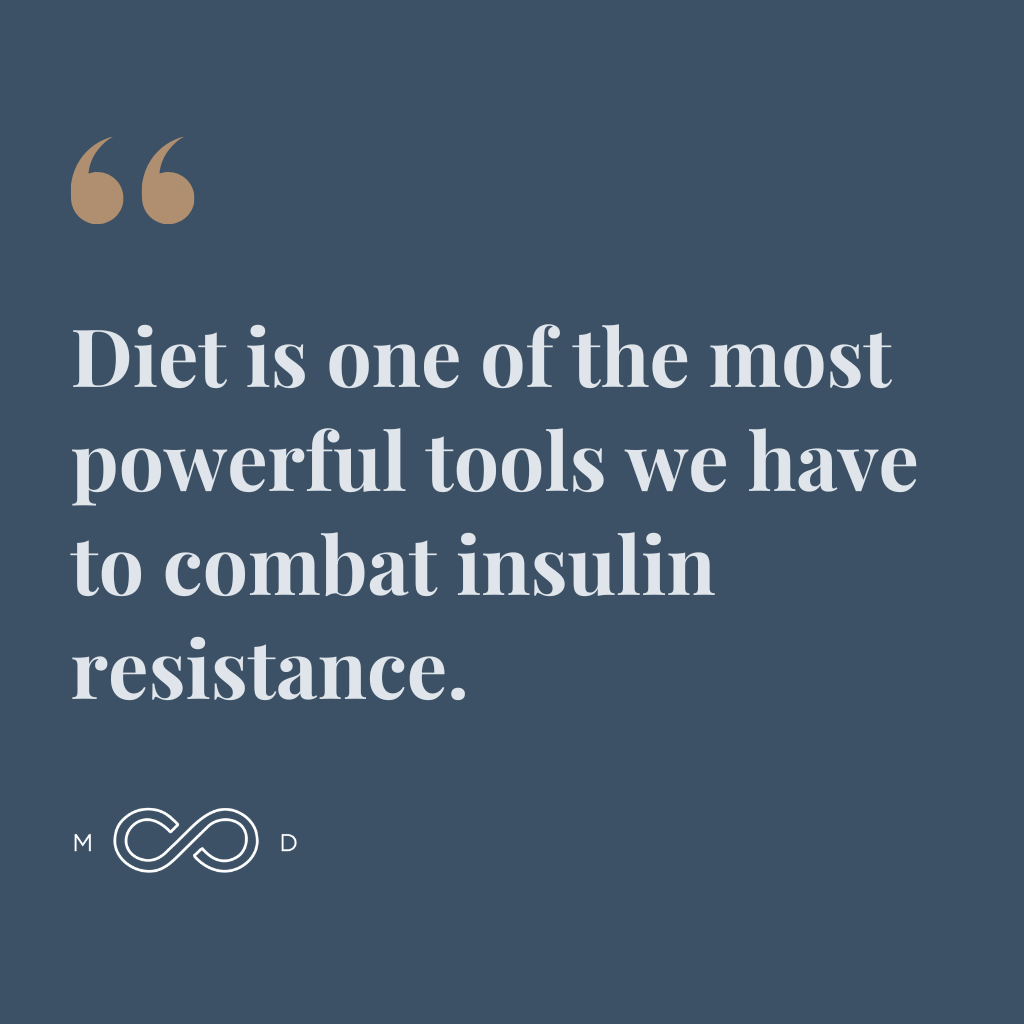If you know me (or my blog), you know I consider blood sugar as one of the most crucial factors in wellness and longevity. In fact, I often refer to optimized blood as the holy grail of human health.
But in the West, we’re beset by food, lifestyle, and culture that work in direct opposition to this goal, inundating us with abundance and limiting our body’s ability to process that abundance. All this leads to chronically elevated blood sugar, insulin resistance, and — eventually — chronic disease.
The good news is that you can make changes that interrupt and even reverse this process, and one powerful way to do that is by adopting an insulin resistance diet.
But before we dive into strategies for addressing insulin resistance, we need to talk about what insulin is, why it’s so important, and how insulin resistance gets going.
Insulin, Resistance, and Diet — Or, What Happens When We Eat
When you eat a meal, your body breaks that meal down into its basic components — fats, proteins, and carbohydrates — for energy and nutritional building blocks.
Carbohydrates, in particular, break down into glucose, or sugar. That sugar moves into your bloodstream for transport, raising what we call your blood sugar. When your body senses this, it tells your pancreas to release a hormone called insulin, which moves that glucose out of your blood and into your body’s muscle, fat, and liver cells.
This process operates in an incredible yet delicate balance. If, every once in a while, you eat refined and processed carbohydrates that quickly spike your blood sugar levels, your body handles the flood of glucose with excess production of insulin. But if you do this daily, which modern life makes extremely easy, then your pancreas remains in constant crisis-management mode.
This continual deluge of insulin to keep you alive causes your body to become increasingly “insensitive” to insulin. Think of it as something like a drug addict who needs higher and higher doses to get the same effect. With insulin, we call it insulin resistance.
One of the most important concepts to grasp here is that insulin resistance doesn’t happen overnight. Insulin resistance is a long, steady process that develops and worsens over time, eventually resulting in type 2 diabetes and a host of other chronic diseases.
The great news is that this means you can intervene in that insulin resistance spectrum, intentionally adopting lifestyle changes that halt and even reverse your progress toward disease.
One crucial factor in standing up against insulin resistance is diet. Your eating habits play a pivotal role in either fueling the fire or helping to put it out.
The Two-Pronged Approach to an Insulin Resistance Diet
Diet is one of the most powerful tools we have to combat insulin resistance. But not just any diet — a strategic diet designed with the root causes of insulin resistance in mind.
When patients ask me about the best diet for insulin resistance, my answer is always, “It depends.” But after years of clinical experience, I’ve found that a generally reliable approach combines two strategies:
1. Time-Restricted Eating: When You Eat Matters
Most traditional diet advice focuses exclusively on what you eat, with a calories in/calories out mentality. But it turns out that when you eat is also important, especially with regard to insulin resistance.
Intermittent fasting is a unique strategy in that it used to be how we ate naturally. In the past, when food and food access were less abundant, we automatically ate less often. Intermittent fasting is simply adopting this pattern intentionally in a modern environment.
As part of an insulin resistance diet, your body gets longer periods of time without eating, allowing it a break from insulin and the opportunity to naturally correct insulin resistance over time.
By maintaining a fasting window of 12–16 hours (which includes your nighttime sleep), you give your body time to:
- Stop producing insulin
- Become more sensitive to insulin
- Access fat stores for energy
- Calm chronic inflammation
It may sound daunting, but for most people, this simply means delaying or skipping breakfast and/or ending your food intake earlier in the evening. This isn’t about eliminating meals; it’s about compressing the window in which you eat them.
Studies show that this approach alone can improve insulin sensitivity, even without changing what you eat.
2. Strategic Carbohydrate Management: What You Eat Matters Too
While intermittent fasting shoulders a lot of burden in an insulin resistance diet, most people need to pull at least two “levers” to see significant results.
Though carbohydrates aren’t inherently “bad,” they are the main source of sugars in our diet (sugar itself is a carbohydrate!). Consuming too many carbs, especially refined ones, demands more insulin from our bodies.
For someone with insulin resistance, a moderate carbohydrate restriction can be transformative. This doesn’t mean eliminating all carbs. Instead, an insulin resistance diet demands a simple strategy:
- Cut obvious offenders: Sugary drinks, desserts, white bread, and other refined carbohydrates spike blood sugar rapidly.
- Be strategic with healthier carbs: Whole grains, fruits, and starchy vegetables should be consumed in moderation and paired with proteins and healthy fats to slow glucose absorption.
- Focus on quality: The nutritional value of the carbohydrates you consume matters tremendously, as does how processed and refined they are.
The combination of fasting plus moderate carbohydrate restriction creates a powerful one-two punch for an effective insulin resistance diet.
Building Your Insulin Resistance Diet
Beyond the core approach above, here are some specific strategies to implement in your insulin resistance diet:
Foods to Emphasize
- Non-starchy vegetables: Leafy greens, broccoli, peppers, and other fiber-rich vegetables should play a big role in your diet.
- Lean proteins: Fish, poultry, eggs, and legumes promote satiety and stable blood sugar.
- Healthy fats: Olive oil, avocados, fatty fish, nuts, and seeds help reduce inflammation and improve insulin sensitivity.
- High-fiber foods: Beans, lentils, and moderate amounts of whole grains slow glucose absorption.
Foods to Limit
- Sugary drinks and foods: Soda, sweetened tea, and desserts cause dramatic blood sugar spikes.
- Refined grains: White bread, white rice, and most packaged snacks have had any beneficial fiber (and nutrients!) removed and spike blood sugar rapidly.
- Processed foods: Fast food, packaged snacks, and processed meats often contain hidden sugars and inflammatory ingredients.
- Excessive alcohol: Alcohol consumption can impair liver function and worsen insulin resistance.
In general, a good rule of thumb I share is this: If it wasn’t food 100 years ago, it isn’t food today. And it will likely contribute to insulin resistance or other disease.
Why an Insulin Resistance Diet Isn’t One-Size-Fits-All
While the principles above apply broadly, how they work for you individually will vary based on your unique lifestyle and biology.
Some people thrive on a 16-hour fast, while others do better with 12–14 hours. Some see remarkable improvements with mild carbohydrate reduction, while others need a more significant restriction.
That’s why having a physician who understands the nuances of insulin resistance — and who will take the time to treat you as an individual — is invaluable.
At Brentwood MD, we work closely with our members to find the right balance of dietary strategies, lifestyle changes, and other factors based on their personalized metabolic profile.
Beyond the Insulin Resistance Diet
While an insulin resistance diet is foundational, a comprehensive approach to metabolic health includes other crucial elements as well:
Exercise: The Natural Blood Sugar Regulator
Besides insulin, exercise is the only other way to reduce free sugar in your blood. When you move your body, your skeletal muscle consumes that sugar first for energy, reducing the need for insulin.
For this reason, regular physical activity is a vital addition to an insulin resistance diet. Strength training, in particular, increases or maintains skeletal muscles — a crucial consideration as we age.
Sleep: The Overlooked Metabolic Regulator
Not everyone realizes the enormous biological impact of sleep — and the lack of sleep. In fact, sleep deprivation is a significant risk factor for developing insulin resistance and diabetes.
Most people require at least seven hours of quality sleep per night. If you aren’t hitting that consistently, I suggest focusing on your sleep hygiene and finding ways to prioritize sufficient sleep.
If you suspect a deeper issue behind your sleeplessness, such as sleep apnea, start a conversation with your physician so you can find a solution together.
Medication: Helpful When Necessary
Dietary and lifestyle changes aren’t always enough to overcome insulin resistance, particularly in more advanced cases. Medications like metformin and, more recently, GLP-1 agonists can be valuable tools to increase your body’s insulin sensitivity.
But remember, medication works best alongside the dietary and lifestyle changes we’ve discussed, not as a replacement for them. While it’s true you might see benefits from popular GLP-1 drugs, like Wegovy or Zepbound, without lifestyle changes, these improvements will be limited in nature and won’t likely remain for the long term if you don’t adjust your habits.
The Path Forward: Conversations to Have With Your Physician
If you’re concerned about insulin resistance or struggling with related conditions like high blood pressure or excess weight, here are three important conversations to have with your physician:
1. “Am I insulin resistant today?”
The first step is determining whether insulin resistance is affecting your health right now. Remember, insulin resistance exists on a spectrum, so looking at trends in certain factors over time is a helpful way to see what direction your blood sugar and insulin status are moving.
Ask your physician about these early indicators of insulin resistance:
- Lipid Panel: Check for elevated LDL cholesterol, ApoB, and triglycerides; low HDL cholesterol; and an unfavorable triglyceride-to-HDL ratio.
- Blood Pressure: Check your blood pressure regularly and start a conversation about management if it averages 135/80 or greater.
- Weight: Excess weight around your midsection, otherwise known as truncal obesity, is a common indicator of insulin resistance. Generally, this means >35 inches for women and >40 inches for men.
- Fasting Glucose: While a later finding, fasting glucose is still a helpful and even critical measurement. If you notice your number climbing over time, or if it reaches 100, you’ll know you’re somewhere on the insulin resistance spectrum.
Other warning signs of insulin resistance include chronic fatigue, low thyroid levels, and low free testosterone (in both men and women).
The beauty of these telltale signs is that they’re your body’s way of waving a red flag. When you pay attention to them, you seize the opportunity to reverse course — with measures like an insulin resistance diet — before it’s too late.
2. “How should I customize my insulin resistance diet for my specific situation?”
While the principles in this article apply broadly, discuss how you can safely tailor your approach to your:
- Current metabolic health
- Medical history
- Personal preferences
- Lifestyle constraints
A physician knowledgeable about metabolic health can help you find the right balance.
3. “Should medication be part of my plan?”
If you’re already experiencing significant insulin resistance, medication might be appropriate alongside an insulin resistance diet.
Ask about options like metformin or GLP-1s, which work by increasing your body’s insulin sensitivity and helping reverse metabolic disease.
Take Control of Your Metabolic Health With an Insulin Resistance Diet
Insulin resistance develops gradually over years, but it can be improved or even reversed with the right approach. By combining time-restricted eating with strategic carbohydrate management, you can directly address the root cause of this condition.
The best insulin resistance diet is the one you can consistently maintain. Make sustainable changes focused on when you eat and what you eat, and you’ll be well on your way to improved metabolic health.
If you’re struggling with insulin resistance or concerned about your metabolic health, finding a physician who understands these nuances can make all the difference in your health journey.

Dr. Aaron Wenzel is a concierge physician specializing in the care of fast-moving entrepreneurs, executives, and public figures in the Nashville, TN area. Dr. Wenzel’s diverse life experience and extensive training in family medicine, emergency care, nutrition, and hormone replacement therapies give him the unique platform to provide unmatched care for his patients.









